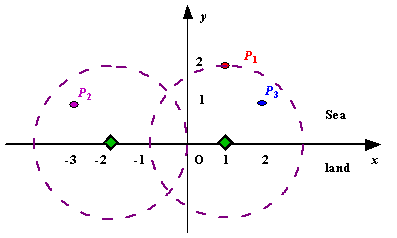POJ 1328 Radar Installation(贪心)
2016-07-25 08:26
417 查看
Radar Installation
Description
Assume the coasting is an infinite straight line. Land is in one side of coasting, sea in the other. Each small island is a point locating in the sea side. And any radar installation, locating on the coasting, can only cover d distance, so an island in the
sea can be covered by a radius installation, if the distance between them is at most d.
We use Cartesian coordinate system, defining the coasting is the x-axis. The sea side is above x-axis, and the land side below. Given the position of each island in the sea, and given the distance of the coverage of the radar installation, your task is to write
a program to find the minimal number of radar installations to cover all the islands. Note that the position of an island is represented by its x-y coordinates.

Figure A Sample Input of Radar Installations
Input
The input consists of several test cases. The first line of each case contains two integers n (1<=n<=1000) and d, where n is the number of islands in the sea and d is the distance of coverage of the radar installation. This is followed by n lines each containing
two integers representing the coordinate of the position of each island. Then a blank line follows to separate the cases.
The input is terminated by a line containing pair of zeros
Output
For each test case output one line consisting of the test case number followed by the minimal number of radar installations needed. "-1" installation means no solution for that case.
Sample Input
Sample Output
题目大意:
有一排海岸线,海岸线平行于X轴,海岸线的附近有很多岛屿,对于海岸线给定岛屿的坐标。问题是需要安装一些雷达来监测这些岛屿,每个雷达的监测半径为m,然后需要在海岸线上安装雷达,问你最少需要安装多少个,可以把所有的岛屿都监测到,输出数量,如果做不到,输出-1
题目解析:
根据给定的岛屿坐标,我们可以计算出每个岛屿在海岸线上安装雷达的区间,意思就是在这个区间内的任何地方安装雷达都是可以检测到此岛屿。这样我们根据n个岛屿的坐标就得到了n个不同的区间在海岸线上,然后我们只贪心的去处理这些区间,让每个区间内至少都存在一个雷达就可以了,那么从第一个区间, 选择最右边一个点, 如果不选择第一个区间最右一个点(选择前面的点), 那么把它换成最右的点之后, 以前得到满足的区间, 现在仍然得到满足, 所以第一个区间的最右一个点为贪婪选择, 选择该点之后, 将得到满足的区间删掉,继续更新最右边的点,直到结束。
#include <algorithm>
#include <iostream>
#include <numeric>
#include <cstring>
#include <iomanip>
#include <string>
#include <vector>
#include <cstdio>
#include <queue>
#include <stack>
#include <cmath>
#include <map>
#include <set>
#define LL long long
#define lson l,m,rt<<1
#define rson m+1,r,rt<<1|1
const LL MAX = 405;
const double esp = 1e-6;
const double PI = 3.1415926535898;
const int INF = 0x3f3f3f3f;
using namespace std;
struct node{
double l,r;
}arr[1005];
bool cmp(node a,node b){
return a.l < b.l;
}
int main(){
int n,Cas = 1;
double m,k,nowx,nowy;
while(~scanf("%d %lf",&n,&m) && (n||m)){
int f = 0;
for(int i=0;i<n;i++){
scanf("%lf %lf",&nowx,&nowy);
if(nowy > m)
f = 1;
arr[i].l = nowx - sqrt(m * m - nowy * nowy);
arr[i].r = nowx + sqrt(m * m - nowy * nowy);
}
sort(arr,arr+n,cmp);
int ans = 1;
k = arr[0].r;
for(int i=0;i<n-1;i++){
if(arr[i+1].l > k){
k = arr[i+1].r;
ans += 1;
}
else if(arr[i+1].r < k){
k = arr[i+1].r;
}
}
if(f)
printf("Case %d: -1\n",Cas++);
else
printf("Case %d: %d\n",Cas++,ans);
}
return 0;
}
| Time Limit: 1000MS | Memory Limit: 10000K | |
| Total Submissions: 75586 | Accepted: 16939 |
Assume the coasting is an infinite straight line. Land is in one side of coasting, sea in the other. Each small island is a point locating in the sea side. And any radar installation, locating on the coasting, can only cover d distance, so an island in the
sea can be covered by a radius installation, if the distance between them is at most d.
We use Cartesian coordinate system, defining the coasting is the x-axis. The sea side is above x-axis, and the land side below. Given the position of each island in the sea, and given the distance of the coverage of the radar installation, your task is to write
a program to find the minimal number of radar installations to cover all the islands. Note that the position of an island is represented by its x-y coordinates.

Figure A Sample Input of Radar Installations
Input
The input consists of several test cases. The first line of each case contains two integers n (1<=n<=1000) and d, where n is the number of islands in the sea and d is the distance of coverage of the radar installation. This is followed by n lines each containing
two integers representing the coordinate of the position of each island. Then a blank line follows to separate the cases.
The input is terminated by a line containing pair of zeros
Output
For each test case output one line consisting of the test case number followed by the minimal number of radar installations needed. "-1" installation means no solution for that case.
Sample Input
3 2 1 2 -3 1 2 1 1 2 0 2 0 0
Sample Output
Case 1: 2 Case 2: 1
题目大意:
有一排海岸线,海岸线平行于X轴,海岸线的附近有很多岛屿,对于海岸线给定岛屿的坐标。问题是需要安装一些雷达来监测这些岛屿,每个雷达的监测半径为m,然后需要在海岸线上安装雷达,问你最少需要安装多少个,可以把所有的岛屿都监测到,输出数量,如果做不到,输出-1
题目解析:
根据给定的岛屿坐标,我们可以计算出每个岛屿在海岸线上安装雷达的区间,意思就是在这个区间内的任何地方安装雷达都是可以检测到此岛屿。这样我们根据n个岛屿的坐标就得到了n个不同的区间在海岸线上,然后我们只贪心的去处理这些区间,让每个区间内至少都存在一个雷达就可以了,那么从第一个区间, 选择最右边一个点, 如果不选择第一个区间最右一个点(选择前面的点), 那么把它换成最右的点之后, 以前得到满足的区间, 现在仍然得到满足, 所以第一个区间的最右一个点为贪婪选择, 选择该点之后, 将得到满足的区间删掉,继续更新最右边的点,直到结束。
#include <algorithm>
#include <iostream>
#include <numeric>
#include <cstring>
#include <iomanip>
#include <string>
#include <vector>
#include <cstdio>
#include <queue>
#include <stack>
#include <cmath>
#include <map>
#include <set>
#define LL long long
#define lson l,m,rt<<1
#define rson m+1,r,rt<<1|1
const LL MAX = 405;
const double esp = 1e-6;
const double PI = 3.1415926535898;
const int INF = 0x3f3f3f3f;
using namespace std;
struct node{
double l,r;
}arr[1005];
bool cmp(node a,node b){
return a.l < b.l;
}
int main(){
int n,Cas = 1;
double m,k,nowx,nowy;
while(~scanf("%d %lf",&n,&m) && (n||m)){
int f = 0;
for(int i=0;i<n;i++){
scanf("%lf %lf",&nowx,&nowy);
if(nowy > m)
f = 1;
arr[i].l = nowx - sqrt(m * m - nowy * nowy);
arr[i].r = nowx + sqrt(m * m - nowy * nowy);
}
sort(arr,arr+n,cmp);
int ans = 1;
k = arr[0].r;
for(int i=0;i<n-1;i++){
if(arr[i+1].l > k){
k = arr[i+1].r;
ans += 1;
}
else if(arr[i+1].r < k){
k = arr[i+1].r;
}
}
if(f)
printf("Case %d: -1\n",Cas++);
else
printf("Case %d: %d\n",Cas++,ans);
}
return 0;
}
相关文章推荐
- how to use adb and gdbserver with VirtualBox - KVM (qemu)
- eclipse中的Console控制台视图脱离主窗口解决办法
- [leetcode] 9. Palindrome Number
- 第一个工程3-代码解释二 ,检查球的的静止和一杆的结束
- 三消游戏死局算法的解析
- 制作一个类似苹果VFL的格式化语言来描述UIStackView
- Spring改版后的下载
- C++中类的静态成员
- iOS对textField进行字符长度限制的办法
- PullToRefresh下拉刷新使用详解
- lucene 过滤
- Intellij打包Maven项目中那些七七八八
- 【杭电】[5748]Bellovin
- CodeForces 540A Combination Lock (水题)
- 国产奶粉的“春天”即将到来
- 国产奶粉的“春天”即将到来
- CentOS的KVM实践(虚拟机创建、网桥配置、Spice)
- NSArray类的分析
- C++ 指针
- 上周热点回顾(7.18-7.24)
